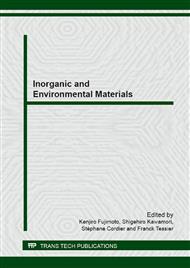p.145
p.149
p.153
p.161
p.166
p.170
p.174
p.179
p.184
Control of Shell Thickness of Hollow Silica-Alumina Composite Spheres and their Activity for Hydrolytic Dehydrogenation of Ammonia Borane
Abstract:
Herein, we investigated the influence of the shell thickness of hollow silica-alumina composite spheres on their activity for hydrolytic dehydrogenation of ammonia borane (NH3BH3). Silica-alumina composite shells were fabricated by coating on polystyrene (PS) template particles and then completely removing the PS by calcination. Based on the transmission electron microscopy images, the shell thicknesses of the hollow spheres prepared using 5, 10, and 15 g of PS suspensions and coating times of 24.0, 7.0, and 1.5 h were 20, 13, and 5 nm, respectively. The results indicated that the shell thickness of homogeneous hollow spheres was controlled by adjusting the amount of PS suspension and the coating time. In the presence of the hollow spheres with shell thicknesses of 5, 13, and 20 nm, 10.0, 9.5, and 9.0 mL of hydrogen was evolved from aqueous NH3BH3 solutions for 13, 12, and 13 min, respectively. The molar ratios of the hydrolytically generated hydrogen to the initial NH3BH3 in the presence of the hollow spheres with shell thicknesses of 5, 13, and 20 nm were 2.6, 2.5, and 2.3, respectively. From these results, it can be inferred that the activity for the hydrolytic dehydrogenation of NH3BH3 increase with decrease of the shell thickness of the hollow spheres. The result of the temperature-programmed desorption profile of ammonia showed that in the number of amount of acid sites of the hollow spheres increase with decrease of the shell thickness of the hollow spheres. The results indicate the activity depends on the number of acid sites of the hollow spheres.
Info:
Periodical:
Pages:
166-169
Citation:
Online since:
June 2014
Authors:
Price:
Сopyright:
© 2014 Trans Tech Publications Ltd. All Rights Reserved
Share:
Citation:


